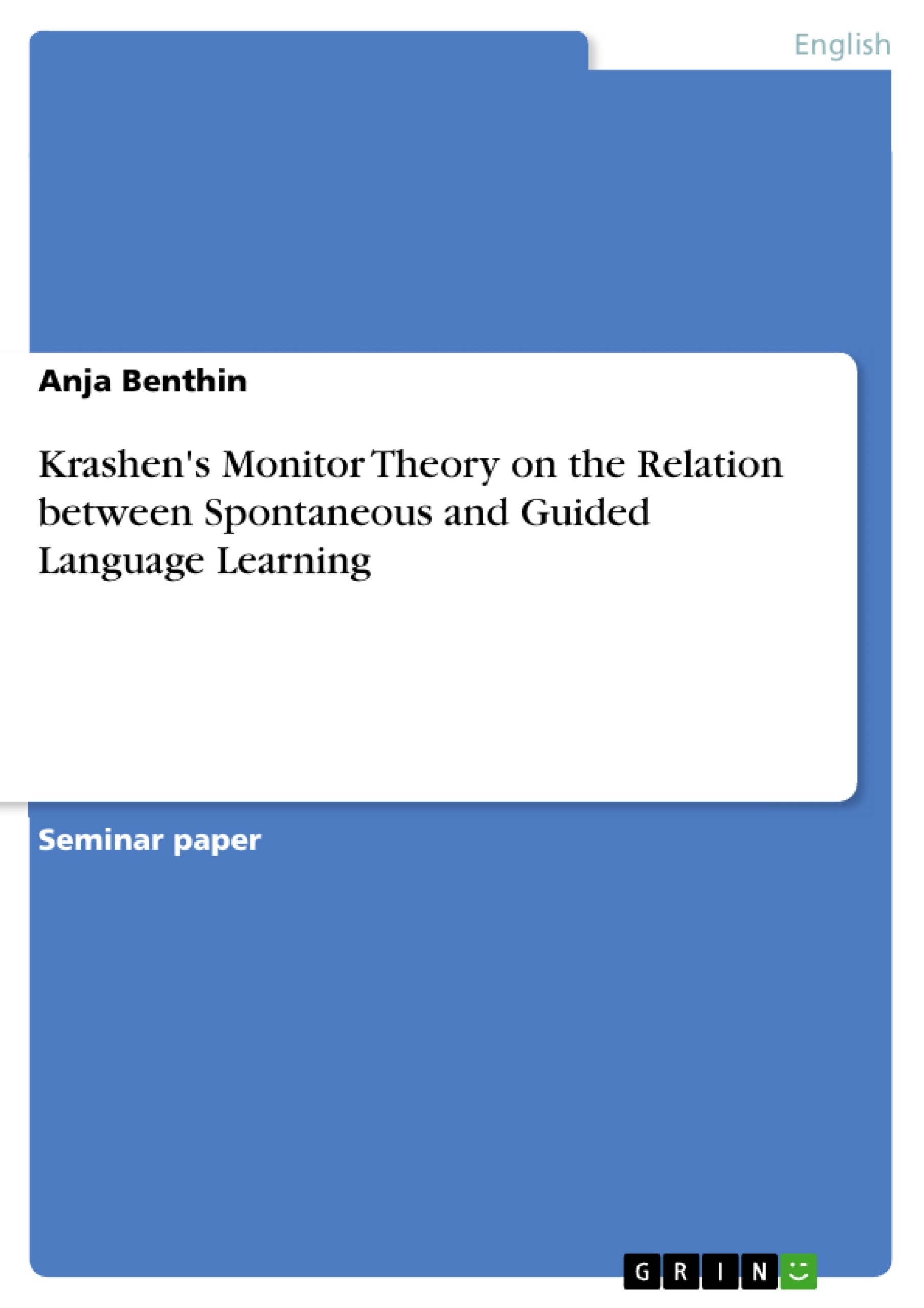Stephen Krashen’s monitor theory tried to provide two explanations of how exactly a second language learner acquires or learns a second language. His theory, although developed around twenty years ago, had an undeniable influence on many linguists and teachers alike. However, there have also been many opponents to his hypotheses. By taking a closer look at Krashen’s theory one will realise that there are a variety of ambiguities and paradoxes involved. Other linguists have conducted studies that show evidence for a different relationship of the two ways of acquiring a second language.
First of all, this essay will provide definitions of the two ways in which a learner can acquire a new language, according to Krashen, which are spontaneous language acquisition and guided language acquisition or using Krashen’s terms acquisition and learning. I will go on trying to demonstrate just how many errors and inadequacies Krashen’s theory contains by providing a summary of Krashen’s monitor theory, containing all of Krashen’s ambiguous ideas. After having gained a general overview of Krashen’s monitor model, objections and criticisms to Krashen’s hypotheses by some of his harshest critics will follow.
In the very last part of this research, I will try to outline some more recent views on the relationship of spontaneous and guided language learning, based on research and studies conducted by other linguists. This will demonstrate that Krashen’s monitor model is not the ideal description of the way learners acquire or learn a second language.
Table of Contents
- Introduction
- Spontaneous Language Learning
- Guided Language Learning
- Krashen's monitor theory
- Criticism of Krashen's theory
- Recent views on Spontaneous and Guided Language Acquisition
- Conclusion
Objectives and Key Themes
The purpose of this research paper is to analyze Stephen Krashen's monitor theory, which posits that language acquisition occurs through two distinct processes: spontaneous language acquisition and guided language learning. The paper aims to examine the theory's strengths and weaknesses, address criticisms raised by other linguists, and explore contemporary research findings that contribute to a deeper understanding of the relationship between these two learning modes.
- Krashen's monitor theory and its central hypotheses.
- Criticisms of Krashen's monitor theory and its limitations.
- The distinction between spontaneous and guided language learning.
- Recent research on the relationship between spontaneous and guided language acquisition.
- The role of conscious learning and subconscious acquisition in second language learning.
Chapter Summaries
- Introduction: This chapter introduces Stephen Krashen's monitor theory and its significance in the field of second language acquisition. It highlights the theory's enduring influence and the controversies it has sparked.
- Spontaneous Language Learning: This chapter defines spontaneous language learning, which occurs through everyday communication and social interaction. It explains how learners acquire language naturally in environments where the target language is spoken as a first language.
- Guided Language Learning: This chapter explores guided language learning, which is a structured and controlled approach to language acquisition. It contrasts the characteristics of guided learning with those of spontaneous learning, emphasizing the emphasis on correctness and formal instruction in the guided setting.
- Krashen's Monitor Theory: This chapter presents Krashen's monitor theory, which proposes five hypotheses explaining the relationship between spontaneous language acquisition and guided language learning. The chapter details each hypothesis and its implications for second language learning.
- Criticism of Krashen's Theory: This chapter examines critiques of Krashen's monitor theory. It highlights the ambiguities, paradoxes, and limitations identified by other linguists, offering alternative perspectives on second language acquisition.
Keywords
The primary keywords and focus topics of this research paper include: Krashen's monitor theory, spontaneous language acquisition, guided language learning, second language acquisition, acquisition vs. learning, monitor hypothesis, natural order hypothesis, linguistic input, communication, and social interaction. The paper explores these concepts to understand the mechanisms and complexities of second language learning.
- Arbeit zitieren
- Anja Benthin (Autor:in), 2005, Krashen's Monitor Theory on the Relation between Spontaneous and Guided Language Learning, München, GRIN Verlag, https://www.grin.com/document/299196



